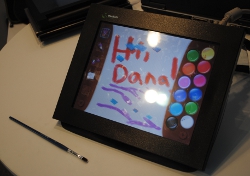



Feature Story
More feature stories by year:
2024
2023
2022
2021
2020
2019
2018
2017
2016
2015
2014
2013
2012
2011
2010
2009
2008
2007
2006
2005
2004
2003
2002
2001
2000
1999
1998
Return to: 2010 Feature Stories
CLIENT: STANTUM
Feb. 18, 2010 : Laptop
 Until now, multitouch, the technology allowing you to pinch Web pages on your iPhone, has had its pros and cons. On the one hand, it’s highly responsive, and the gestures it enables– pinching, zooming, rotating photos– are intuitive.
Until now, multitouch, the technology allowing you to pinch Web pages on your iPhone, has had its pros and cons. On the one hand, it’s highly responsive, and the gestures it enables– pinching, zooming, rotating photos– are intuitive.
On the other hand, even the best multitouch screens limit you to using four fingers at once, so you need to make sure you’re not touching it with two hands. You also can’t touch these displays while wearing gloves or using a blunt object, such as a stylus.
For years, French company Stantum has had a multitouch solution that answers both these problems. But just this week the company announced deals with two global chip makers, ST and Sitronix, for chips to become available to OEMs in the second quarter of this year. That means this enhanced multitouch technology could finally start shipping in laptops and tablets.
Since 2004, Stantum has had a multitouch technology that allows users to touch the display with all ten fingers at once. Moreover, it works with a stylus, so users can seamlessly move back and forth between finger input and, say, handwriting recognition.
The company even recently updated the technology so that it registers finger pressure. In a paint program, for example, when you drag your finger lightly, a faint streak will appear; when you bear down, a thick blot of digital ink will start pooling out from beneath your finger. And artistic apps are only one usage scenario: imagine what game developers could do if our screens registered finger pressure.
Return to: 2010 Feature Stories